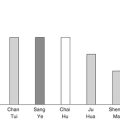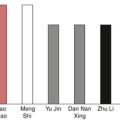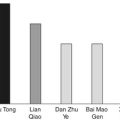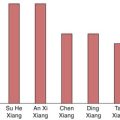Chapter Six. Herbs that transform Dampness
 |
1. What are the indications for herbs that transform and drain Dampness? What are the characteristics of the syndrome of Dampness accumulation?
Herbs that transform and drain Dampness are used for treating syndromes of accumulation of Dampness in the body. These syndromes are usually due to disturbance of the water metabolism, which is a result of dysfunction of the Lung, Spleen, Kidney, Bladder or San Jiao meridians.
The symptoms of Dampness accumulation are edema, scanty and difficult urination, retention of urine, fullness of the chest, a large amount of phlegm, asthma, distension of the abdomen, diarrhea, pain in the joints and heaviness of the body. If Dampness is complicated with Heat in the Middle or Lower Jiao, then disorders such as jaundice, skin diseases and infections from various pathogenic microorganisms may be present.
Dampness is a Yin pathogenic factor and it has a stagnating tendency. This characteristic is shown not only by the symptoms, such as heaviness, fullness and numbness of the body, but also by a lingering, recurrent or chronic course to the disease.
If Dampness is complicated by other pathogenic factors, especially Heat, it will be very difficult to separate these out because to clear Heat may injure the Spleen-Yang and increase Dampness, and to remove Dampness may injure the Yin and increase Heat, so the course of treatment will be longer than if treating disorders caused by only one exogenous pathogenic factor.
2. What are the characteristics of the herbs that transform and drain out Dampness? What precautions should be observed in the use of these herbs?
Herbs that transform and drain Dampness are able to eliminate it by promoting urination and reducing the accumulation of water; therefore they can treat those syndromes and symptoms caused by the accumulation of Dampness or water. These herbs have the following characteristics.
Bland taste
Since a bland taste has the ability to leach out Dampness by promoting urination, most of the herbs that increase urination and drain out Dampness are bland, including Fu Ling ( Poria), Zhu Ling ( Polyporus), Ze Xie ( Alismatis rhizoma), Hua Shi ( Talcum), Yi Yi Ren ( Coicis semen), Tong Cao ( Tetrapanacis medulla), Che Qian Zi ( Plantaginis semen) and Deng Xin Cao ( Junci medulla).
Sweet, bland and cold
Blandness has the ability to leach out water or Dampness and it has a descending tendency in action. Cold can clear Heat, and sweetness and Cold can generate the Yin and Body Fluids, which may have been injured by pathogenic Heat or by the draining action of some herbs. These herbs are suitable for treating water accumulation that is complicated with Heat, especially when the accumulation is in the Lower Jiao. Sweet-bland-cold herbs are also suitable for situations where draining actions are required in this area. The commonly used herbs in this category are Hua Shi, Yi Yi Ren, Tong Cao, Deng Xin Cao, Zhu Ling, Ze Xie and Che Qian Zi.
Sweet, bitter and cold
Some of the herbs are sweet, bitter and cold in nature. They are excellent herbs for treating Damp-Heat accumulation. Because bitterness can dry Dampness and direct Fire downwards, sweetness can tonify the body, and Cold can clear Heat, the bitter-cold nature of these herbs can strongly reduce Heat, and their sweet-cold nature can generate the Yin and Body Fluids, which may have been injured by pathogenic Heat or by the draining action of some herbs. These herbs can be used for a longer period of time than the bitter-cold herbs that dry Dampness and clear Heat. The commonly used herbs are Di Fu Zi ( Kochiae fructus), Shi Wei ( Pyrrosiae folium) and Jin Qian Cao ( Lysimachiae herba).
Entering the Bladder, Kidney and Small Intestine meridians
Because, according to TCM, urination is carried out by the Kidney, the Bladder and the Small Intestine, most of the herbs enter these meridians. They also enter other meridians such as the Lung, Spleen and Large Intestine. They can also regulate the function of these organs and meridians and improve water metabolism.
Moreover, some herbs that drain Dampness can open up meridians and collaterals. They also have the function of increasing the secretion of milk and therefore treat lactation problems.
Herbs that transform and drain out Dampness should be used with caution. Generally speaking, they are suitable only for treating Excess syndromes. In treatment, herbs that regulate the Liver-Qi or the Qi of the San Jiao meridian should also be used because Qi stagnation may directly obstruct the water passage and cause water accumulation. Furthermore, in treating accumulation of Dampness caused by weakness of the Qi and Yang of the Heart, Lung, Spleen and Kidney, herbs that drain out Dampness can be prescribed only if they are combined with herbs that tonify the Yang and Qi.
Herbs that treat Cold-Dampness have a pungent-warm, bitter-warm or bland nature, and they should be used with caution because they can consume the Yin if they are used in large dosage and for a long period of time. The herbs that treat Damp-Heat have a bitter and cold nature, which can injure the Yang of Spleen and that may increase the dampness accumulation. Therefore, the dosage and treatment period should be carefully considered. Moreover, pregnant women should use these herbs with caution as these aromatic, pungent, bitter and bland herbs can activate Qi and Blood, and the bitter and bland herbs usually move downwards. These actions may bring danger to the pregnancy.
3. What are the commonly used methods for eliminating Dampness?
Dampness is one of the six exogenous pathogenic factors. It is also a pathological product caused by disorder of water metabolism in the body. The associated organs are the Kidney, Bladder, Small Intestine, Spleen, Lung and San Jiao. To eliminate the accumulation of Dampness or water, there are several possibilities. The commonly used strategies are as follows.
Promoting urination and leaching out Dampness
Bland or bland-sweet-cold herbs, which enter the Bladder, Small Intestine and Kidney meridians, can promote urination and reduce accumulation of water or Dampness directly. They are particularly suitable for use where there is water accumulation in the Lower Jiao. The commonly used herbs are Fu Ling ( Poria) and Ze Xie ( Alismatis rhizoma).
Drying Dampness
Pungent-bitter-warm herbs can dry Dampness directly. They are particularly suitable when water or Dampness accumulates in the Middle Jiao. The commonly used herbs are Cang Zhu ( Atractylodis rhizoma), Hou Po ( Magnoliae cortex), Ban Xia ( Pinelliae rhizoma) and Du Huo ( Angelicae pubescentis radix).
Bitter-cold herbs are able to clear Heat and dry Dampness and they are often used for transforming Damp-Heat. Examples are Huang Qin ( Scutellariae radix), Huang Lian ( Coptidis rhizoma), Huang Bai ( Phellodendri cortex) and Zhi Zi ( Gardeniae fructus).
Expelling Dampness
Pungent herbs have the function of expelling Wind and can also disperse and transform Dampness. These herbs can be used alone if the Dampness accumulates in the Upper Jiao. They can also be used in combination with other methods for treating Dampness in the Middle Jiao and Lower Jiao. The commonly used herbs are Fang Feng ( Saposhnikoviae radix), Qin Jiao ( Gentianae macrophyllae radix) and Qiang Huo ( Notopterygii rhizoma).
Aromatically transforming Dampness
Because aromatic herbs can penetrate turbidity, revive the Spleen and transform Dampness, they are particularly suitable for situations where Dampness obstructs the sense orifices. These herbs are Huo Xiang ( Agastachis herba), Pei Lan ( Eupatorii herba), Cao Guo ( Tsaoko fructus), Sha Ren ( Amomi xanthioidis fructus) and Qing Hao ( Artemisiae annuae herba).
Strengthening the function of the Spleen and transforming Dampness
Herbs that tonify the Qi of the Spleen so as to strengthen the function of water transportation and transformation are often used in a Dampness syndrome; examples are Bai Zhu ( Atractylodis macrocephalae rhizoma) and Huang Qi ( Astragali radix).
Warming the Kidney-Yang and ‘steaming’ the Dampness
Pungent-hot herbs that enter the Kidney meridian are able to strengthen the Kidney-Yang, to ‘steam’ the water, to separate the clean water from the turbid part and accelerate the water metabolism. They are often used for chronic or severe cases of accumulation of water or Dampness in the body. The commonly used herbs are Fu Zi ( Aconiti radix lateralis preparata)*, Rou Gui ( Cinnamomi cassiae cortex) and Wu Yao ( Linderae radix).
Warming the Spleen-Yang and transforming Dampness
Pungent-hot herbs that enter the Spleen meridian are able to strengthen the Spleen-Yang, accelerate the transportation and transformation of the Spleen, and therefore transform Dampness. The commonly used herbs are Sheng Jiang ( Zingiberis rhizoma recens) and Gan Jiang ( Zingiberis rhizoma).
Dispersing the Lung-Qi and regulating the water passage
Since water is moved by the Qi in the body, herbs that can disperse the Lung-Qi can also disperse Dampness; examples are Ma Huang ( Ephedrae herba)* and Jie Geng ( Platycodi radix).
For the same reason, herbs that direct the Lung-Qi to descend can also be used to regulate the passage of water and eliminate Dampness; examples include Sang Bai Pi ( Mori cortex), Xing Ren (Xing Ren) and Ting Li Zi ( Lepidii/Descurainiae semen).
Promoting the Qi movement and eliminating Dampness
Since the movement of Qi can accelerate water metabolism, herbs that promote Qi movement can treat accumulation of Dampness. This strategy is often combined with other methods. The commonly used herbs are Xiang Fu ( Cyperi rhizoma), Chen Pi ( Citri reticulatae pericarpium), Da Fu Pi ( Arecae pericarpium) and Hou Po ( Magnoliae cortex).
4. Fu Ling ( Poria) can promote urination, tonify the Spleen and calm the Mind. What are its characteristics compared with other herbs which have the same function?
Fu Ling is sweet, bland and neutral, and enters the Heart, Spleen, Stomach, Lung and Kidney meridians. It is able to drain out Dampness by promoting urination. It can also tonify the Spleen and calm the Mind.
Compared with the other herbs that transform Dampness, Fu Ling is characterized by being used for both Damp-Heat and Damp-Cold syndromes to promote urination and drain out Dampness; this is because it is bland and neutral in nature. Because it is sweet and bland, it drains out Dampness without the side-effect of injuring the Yin and Yang of the body. In clinical practice, it is often used for treating accumulation of water and Dampness in the Middle or Upper Jiao, manifesting as edema, heaviness of the body and difficult urination, such as in the diseases of the Kidney, Lung, Liver and Heart.
Comparing Fu Ling with other herbs that tonify the Spleen, its neutral and gentle nature brings this herb its characteristic actions: Fu Ling is white in color and has no taste; it has a gentle action of tonifying the Spleen-Qi but is without a cloying nature. It can therefore be used for treating chronic disorders and for people who have a weak constitution and are very sensitive to the tastes of most herbs. For the same reason, this herb is also recommended in prescriptions for children. It is also an ideal herb for putting in biscuits, cakes, soup or porridge and using in the diet over a longer period of time. Another characteristic of Fu Ling is that it not only tonifies the Spleen, but also transforms Dampness and moves it downwards. Unlike most of the tonifying herbs, which place extra burden on the Stomach and must be used with herbs that regulate the Qi, Fu Ling can be used alone without any side-effects. It is especially useful in patients suffering from edema, difficult urination and diarrhea caused by Spleen deficiency.
Comparing Fu Ling with other herbs that calm the Mind, it is most suitable for treating restlessness, palpitations and insomnia due to deficiency of the Heart-Qi and Spleen-Qi. These patients may also suffer from poor appetite, tiredness, excessive thinking, depression and restless sleep. In most cases, there is a history of chronic disease or long-term mental stress. Fu Ling has no special taste, so it is a good herb for children suffering from restless sleep, crying at night and indigestion.
5. What are the differences between Fu Ling ( Poria), Fu Ling Pi ( Poriae cocos cortex), Fu Shen ( Poriae cocos pararadicis) and Chi Fu Ling ( Poriae cocos rubrae)?
Fu Ling is sweet, bland and neutral, and enters the Heart, Spleen, Stomach, Lung and Kidney meridians. It is able to drain out Dampness by promoting urination, and tonifies the Spleen. It can also calm the Mind gently.
Fu Ling Pi is the peel of Fu Ling. Unlike Fu Ling, it does not have the function of tonifying the Spleen and calming the Mind, but it is especially effective for transforming Dampness in the skin and subcutaneous regions by promoting urination; therefore it can treat edema and puffiness.
The parts of the fungus around the root are called Fu Shen. Fu Shen has the same function as Fu Ling, but its effect in calming the Mind is stronger, which is why it has ‘S hen’, meaning ‘Mind’ or ‘Spirit’, in its name.
Chi Fu Ling means, in Chinese, ‘the red Fu Ling’. In fact, it is completely different from Fu Ling. Although it can promote urination and treat water accumulation in the Lower Jiao, it is cold in nature and is used to treat Damp-Heat syndrome. It cannot tonify the Spleen, nor calm the Mind.
6. Fu Ling ( Poria), Zhu Ling ( Polyporus), Ze Xie ( Alismatis rhizoma) and Yi Yi Ren ( Coicis semen) are all sweet and bland, and are able to transform and drain out Dampness. What are the differences between the four herbs?
Fu Ling, Zhu Ling, Ze Xie and Yi Yi Ren are all sweet and bland. Sweetness can tonify the body and blandness can drain out Dampness. These four herbs are characterized by being able to drain out Dampness without the side-effects of consuming the Yin and Qi of the body. All four can be used for the situations where Dampness accumulates in the Middle Jiao and Lower Jiao, obstructing the Qi and water passage. Manifestations of this condition are distension of the abdomen, feelings of heaviness in the body, edema in the legs and difficult urination or retention of urine. In clinical practice, the four herbs can be used for ascites, edema and oliguria due to disease of the heart, liver or kidney.
Zhu Ling and Ze Xie enter the Kidney and Bladder meridians, and they can treat Dampness accumulation in the Lower Jiao. However, Zhu Ling only has the function of promoting urination and draining out Dampness and is used to treat edema and difficult urination. Ze Xie not only promotes urination but also reduces Empty-Fire from the Kidney and is suitable for treating cystitis and urinary tract infection during menopause.
Of the four herbs, Fu Ling and Yi Yi Ren have a wider range of functions than Zhu Ling and Ze Xie. Fu Ling also enters the Heart, Spleen and Stomach meridians. It has the function of calming the Mind and can be used for treating restlessness, palpitations, restless sleep and pensiveness due to deficiency of the Spleen-Qi and Heart-Qi. Yi Yi Ren can clear Heat and transform pus. It is often used for treating pulmonary abscess and many kinds of infections of the intestine. Nowadays, it is also used in formulas of treating cancers if combined with other herbs. Since Yi Yi Ren enters the Spleen meridian and clears Damp-Heat, it can also be used to treat Hot-Bi syndrome, which is characterized by swollen, warm and painful joints, and heaviness and numbness of the limbs. It is also a commonly used herb to treat skin disorders caused by Damp-Heat; the skin lesions are itchy, weepy and red, such as in eczema.
7. Mu Tong ( Mutong caulis)* and Tong Cao ( Tetrapanacis medulla) can both promote urination, drain Damp-Heat and promote lactation. What are the differences between them?
Mu Tong and Tong Cao can both promote urination and drain out Dampness. Both are often used for treating edema and retention of urine as well as scanty, painful, frequent and difficult urination due to Damp-Heat accumulation, such as in acute urinary tract infection, cystitis, pyelitis and prostatitis. Both are also able to promote lactation and are used for insufficient lactation after giving birth.
However, Mu Tong is bitter and cold, and enters the Heart and Small Intestine meridians. It characteristically promotes urination and drains Heat from the Heart via the Small Intestine. Its action in clearing Fire and draining out Dampness is stronger than that of Tong Cao. It is particularly effective for treating Painful Urinary Dysfunction syndrome where the Fire is transmitted from the Heart to the Small Intestine. Since Heart-Fire is often caused by the Liver-Fire, Mu Tong is more suitable for treating urinary disorders which start or worsen under stress and are accompanied by irritability, insomnia, ulceration on the tongue, a bitter taste in the mouth and thirst.
Tong Cao is sweet, bland and cold. It enters the Spleen and Stomach meridians and it is light in nature. Cold can reduce Heat and blandness can promote urination and leach out Dampness. Its action of draining out Dampness and reducing Heat is gentler than that of Mu Tong. It is used only when the Qi and water accumulate in the Lower Jiao. However, compared with Mu Tong, it has less potential to injure the Qi, Yang and Yin as it is not bitter and cold, but sweet and cold, and so it can be used for a longer period of time.
Both Mu Tong and Tong Cao can promote lactation, but Mu Tong achieves this by opening up the meridians and promoting Blood circulation, thereby promoting lactation. Tong Cao enters the Stomach meridian (which passes through the breasts) and then enters the Qi level; it stimulates lactation by promoting the Qi movement. Mu Tong and Tong Cao are often used together to promote Qi movement and Blood circulation in order to promote lactation.
In addition, since Mu Tong can open up the meridians and promote Blood circulation, it is also used for treating Damp-Heat in the meridians, such as in Hot-Bi syndrome, which manifests as heaviness and numbness of the limbs, and swollen, warm and painful joints. It can also be used for irregular menstruation caused by Damp-Heat in the Lower Jiao and stagnation of the Blood. Tong Cao can clear Heat from the Lung as well as increasing urination.
Mu Tong has, in fact, several names that sound similar. Special attention should be paid to Guan Mu Tong ( Hocquartiae manshurensis caulis)* which can cause serious kidney damage. It is banned in Western countries and in China. It can be replaced by Chuan Mu Tong ( Clematidis armandii caulis) or Wu Ye Mu Tong ( Akebiae caulis) with careful control of both the Chinese names and the Latin equivalents.
8. What are the functions of and differences between Han Fang Ji ( Stephaniae tetrandrae radix) and Mu Fang Ji ( Aristolochiae fangchi radix)*
Han Fang Ji and Mu Fang Ji are very bitter, cold and pungent, and enter the Bladder, Lung and Spleen meridians. Bitterness and Cold can reduce Heat and drain out Dampness. Pungency can expel Wind and alleviate pain. Both herbs are used for eliminating Damp-Heat in the Lower Jiao at the Blood level, promoting urination, and reducing edema and oliguria in pulmonary heart disease, rheumatic heart disease and nephritis. They can also be used for treating painful, swollen and heavy joints and limbs in rheumatic fever. Comparing the functions of these two herbs, Han Fang Ji is stronger in promoting urination and reducing edema; Mu Fang Ji is stronger in expelling Wind and Dampness so as to alleviate pain.
In addition, Mu Fang Ji is considered to be a toxic herb which may lead to serious kidney damage, especially when it is used for a long period of time and with a wrong combination in a formula. It is banned both in Western countries and in China.
9. Yin Chen Hao ( Artemisiae scopariae herba) and Qing Hao ( Artemisiae annuae herba) are both able to transform Damp-Heat, reduce low-grade fever and relieve jaundice. What are the differences between them?
Yin Chen Hao and Qing Hao are bitter and cold and have a light, fragrant smell. Both are commonly used for transforming Damp-Heat, eliminating Exterior Damp-Heat and treating symptoms such as heaviness of the head, body and limbs, a sense of constriction in the chest, nausea, loss of appetite, distension in the abdomen and intermittent fever and chills. These symptoms are often seen in sunstroke, summer cold infections, influenza, acute enteritis and dysentery. Both of them can clear Damp-Heat from the Liver and Gall Bladder and relieve jaundice in hepatitis or malaria, in which Damp-Heat accumulates in the Middle Jiao and disturbs the secretion of bile. These two herbs can also reduce low-grade fever and are used for Interior disorders, but the functions and applications are different.
Yin Chen Hao is bitter and slightly cold. Its light and fragrant smell can penetrate the turbid Damp-Heat and separate the Dampness from the Heat. Since Yin Chen Hao enters the Spleen, Stomach, Liver and Gall Bladder meridians, it is particularly effective for treating Damp-Heat accumulation in these organs and meridians. It treats low-grade fever, in which patients complain that their temperature is not high but nevertheless they feel warm inside and the warmth does not radiate to the outside; these symptoms indicate the Heat is constrained by Dampness. Patients may also have symptoms and signs such as tightness in the chest, distension in the abdomen, a white or yellow sticky tongue coating and a soft pulse. Moreover, Yin Chen Hao is also the most important herb for relieving jaundice when Damp-Heat obstructs the bile secretion and the bile is pressed into the Blood. Therefore it is often used for treating acute hepatitis, cholecystolithiasis, angiocholitis, cholecystitis and hemolytic jaundice.
Qing Hao is also a bitter and cold herb, and it is colder than Yin Chen Hao. It also has a light and fragrant smell, but it particularly penetrates into the Blood and Yin levels and disperses Heat there. It also enters the Liver and Gall Bladder meridians and is effective for clearing Heat in these organs and meridians. Compared with Yin Chen Hao, which reduces low-grade fever, it is especially effective for reducing Heat in the Blood and Yin levels when the Blood and Yin have been injured by Heat because its light and fragrant smell can disperse and bring Heat out of the deep layers of the body. It is more often used when patients feel ‘bone steaming’ and low-grade fever only at night. In this situation, patients have a red tongue body with no coating and a thready, rapid pulse. Compared with Yin Chen Hao, its effect in cooling the Blood and reducing Empty-Heat in treating lower-grade fever is stronger, but it is weaker than Yin Chen Hao in reducing low-grade fever due to Damp-Heat. It can also be used to relieve jaundice in malaria; artemisin, which is extracted from Qing Hao, is able to kill the malaria parasite in vitro so as to reduce jaundice.
10. Bian Xu ( Polygoni avicularis herba), Qu Mai ( Dianthi herba) and Bi Xie ( Dioscoreae hypoglaucae rhizoma) can be used in treating Painful Urinary Dysfunction syndrome. What are the differences between them?
Bian Xu, Qu Mai and Bi Xie are all able to promote urination, drain out Dampness and treat Painful Urinary Dysfunction syndrome, which is characterized by frequent, urgent, difficult and painful urination. But there are differences between these three herbs.
Bian Xu is bitter, slightly cold and enters the Stomach and Bladder meridians. Bitterness and Cold can clear Heat and drain out Dampness. It is good at clearing Heat and transforming Dampness when Dampness and Heat are both strong in the Lower Jiao. The manifestations of this condition are difficult and painful urination, scanty urine, a red tongue with a yellow sticky coating and a soft pulse.
Qu Mai is bitter and cold and enters the Blood level of the Heart, Kidney, Small Intestine and Bladder meridians. It is able to clear Heat and cool the Blood in the Small Intestine and drain out Heat. It is especially effective for treating Painful Urinary Dysfunction syndrome caused by Damp-Heat in which the Heat is more pronounced than the Dampness. The symptoms are very scanty, dark urine, blood in the urine, painful and burning sensations during micturition, irritability, a bitter taste in the mouth, a red tongue without coating, and a wiry and rapid pulse.
Bi Xie is bitter and neutral and enters the Liver, Stomach and Bladder meridians. It does not have the function of clearing Heat, but it is able to separate Dampness from Heat and the clean part of water from the turbid part; it is also good at eliminating Dampness. Bi Xie is particularly used for treating cloudy urine or a large amount of leukorrhea due to Dampness accumulation in the Lower Jiao. In clinical practice, this herb is often used for chronic nephritis. Furthermore, its preparation has an inhibitory effect against some intestinal parasites and many pathogenic fungi.
11. Qu Mai ( Dianthi herba), Shi Wei ( Pyrrosiae folium), Hai Jin Sha ( Lygodii spora) and Jin Qian Cao ( Lysimachiae herba) can be used for Blood-Painful Urinary Dysfunction syndrome. What are the differences between them?
These four herbs are able to promote urination and clear Damp-Heat and are used especially for treating Blood-Painful Urinary Dysfunction syndrome when the Damp-Heat in the Lower Jiao has injured the blood vessels. In clinical practice, they are used in the treatment of urinary tract dysfunction, cystitis, cystolithiasis, pyelitis, nephrolithiasis and ureterolithiasis. However, each herb has its own characteristics, thus they are often used together to enhance the therapeutic effects.
Qu Mai is bitter and cold and enters the Blood level. It can strongly reduce Heat from the Heart and Small Intestine and drain out Heat. It is a commonly used herb for treating Painful Urinary Dysfunction syndrome when the Heat is pronounced and has injured the blood vessels.
Shi Wei is sweet, bitter and slightly cold and enters the Lung and Bladder meridians. It can clear Heat from the Lung and regulate the water passage; therefore it can regulate the function of the Bladder. As it can also stop bleeding, it is often chosen to treat Blood-Painful Urinary Dysfunction syndrome.
Hai Jin Sha is sweet, salty and cold and enters the Small Intestine and Bladder meridians. It can clear Heat and transform Dampness by promoting urination. As it is particularly effective for relieving pain in the urinary tract, it can be used for different types of Painful Urinary Dysfunction syndrome. Since pain is pronounced in the Blood- and Stone-Painful Urinary Dysfunction syndromes, Hai Jin Sha is very often used in these two types of disorder.
Jin Qian Cao is bitter, pungent, cool and slightly salty. It enters the Lung, Liver and Gall Bladder meridians. It is able to promote urination and eliminate stones, therefore it can stop bleeding. It is especially suitable for use in Stone-Painful Urinary Dysfunction syndrome when there is blood in the urine.
12. Which herbs can regulate the function of the Bladder and promote urination? What are the applications? How should one use them in clinical practice?
The herbs that regulate the function of the Bladder and promote urination are Fu Ling ( Poria), Zhu Ling ( Polyporus), Ze Xie ( Alismatis rhizoma), Han Fang Ji ( Stephaniae tetrandrae radix), Hua Shi ( Talcum), Di Fu Zi ( Kochiae fructus), Bian Xu ( Polygoni avicularis herba), Bi Xie ( Dioscoreae hypoglaucae rhizoma), Shi Wei ( Pyrrosiae folium), Hai Jin Sha ( Lygodii spora), Dong Kui Zi ( Malvae semen) and Che Qian Zi ( Plantaginis semen).
The indications for using these herbs are edema, retention of urine, oliguria, distension in the abdomen and heaviness of the limbs; the tongue coating is white and the pulse is soft. In clinical practice, these herbs are used for edema, ascites, oliguria and retention of urine in chronic nephritis, diseases of the lung and liver and renal failure or heart failure.
In order to increase the therapeutic effects, these herbs are often used with herbs that regulate the Qi of the Lung and Spleen, regulate the San Jiao water passage, and tonify the Qi and Yang of the Spleen and Kidney to treat the causes of water accumulation.
13. Which herbs can clear Heat from the Heart and Small Intestine and promote urination? What are the indications for them?
The herbs that clear Heat from the Heart and Small Intestine and drain out Damp-Heat by promoting urination are Mu Tong ( Mutong caulis)*, Zhi Zi ( Gardeniae fructus), Qu Mai ( Dianthi herba), Deng Xin Cao ( Junci medulla), Dan Zhu Ye ( Lophatheri herba), Yu Mi Xu ( Maydis stigma) and Chi Xiao Dou ( Phaseoli semen).
The indications for using these herbs are irritability, restlessness, thirst, a bitter taste in the mouth, scanty or bloody urine and painful and difficult micturition. The tongue is red with a yellow coating and the pulse is rapid, wiry and slippery. In clinical practice, these herbs are used for treating acute urinary tract infection, cystitis, pyelitis, acute prostatitis and painful and difficult urination in menopausal syndrome.
14. Which herbs can clear Heat from the Lung and promote urination? What are the indications for them?
The herbs that clear Heat from the Lung and promote urination are Shi Wei ( Pyrrosiae folium), Ban Bian Lian ( Lobelia chinensis herba), Tong Cao ( Tetrapanacis medulla), Dong Gua Zi ( Benincasae semen), Han Fang Ji ( Stephaniae tetrandrae radix), Sang Bai Pi ( Mori cortex) and Ting Li Zi ( Lepidii/Descurainiae semen).
The indications for using these herbs are coughing with phlegm, wheezing, asthma, edema and difficult urination. The tongue is red with a white coating and the pulse is rapid and superficial, especially in the region of the Lung. The symptoms are caused by obstruction of the Lung-Qi and the Bladder-Qi. In clinical practice, these herbs can be used in asthma, chronic bronchitis, pulmonary emphysema, acute nephritis, pulmonary heart disease, rheumatic heart disease and heart failure.
15. Which herbs can regulate the Spleen, promote urination and drain out Dampness? What are the indications for them?
The herbs that can regulate the function of the Spleen and eliminate Dampness by promoting urination are Fu Ling ( Poria), Yi Yi Ren ( Coicis semen), Tong Cao ( Tetrapanacis medulla), Bi Xie ( Dioscoreae hypoglaucae rhizoma) and Da Fu Pi ( Arecae pericarpium).
The indications for using these herbs are scanty urine, retention of urine, difficult urination, edema (especially in the legs), ascites, a large amount of leukorrhea, diarrhea, lack of appetite and heaviness of the body. The tongue is flabby with a thick white coating, and the pulse is soft. In clinical practice, these herbs can be used for chronic prostatitis, chronic pelvic inflammatory disease, chronic hepatitis, nephritis and nephritic syndrome.
16. Which herbs can transform Damp-Heat in the Middle Jiao and Lower Jiao and are used for treating skin diseases and infections? Huang Qin ( Scutellariae radix), Huang Lian ( Coptidis rhizoma), Huang Bai ( Phellodendri cortex) and Long Dan Cao ( Gentianae radix) are also able to remove Damp-Heat and treat these disorders. What are the differences between these two groups of herbs?
Some herbs that can transform Dampness in the Middle Jiao and Lower Jiao are particularly useful for treating skin diseases and infections. The commonly used herbs are Fu Ling ( Poria), Yi Yi Ren ( Coicis semen), Bian Xu ( Polygoni avicularis herba) and Di Fu Zi ( Kochiae fructus). These herbs, as well as Huang Qin, Huang Lian, Huang Bai and Long Dan Cao, are often used in conditions where there is accumulation of Damp-Heat in the Middle Jiao and Lower Jiao, and can treat skin diseases characterized by red, itchy and weepy skin lesions and infections caused by pathogenic microorganisms, including eczema, tinea, pemphigus, herpes zoster, trichomonas vaginitis, monilial vaginitis and vulvitis. However, there are some differences between these two groups of herbs.
First of all, they have different tastes and enter different meridians. The herbs in the first group are mainly bland and cold in nature, and enter the Bladder meridian. In treating Damp-Heat, their action is primarily that of leaching out Damp-Heat by promoting urination because Dampness and Heat are not very easy to separate. The herbs in the second group are very bitter and cold, and enter the Heart, Liver, Stomach and Bladder meridians. Their action is primarily that of strongly reducing Heat and drying Dampness in the Middle or Lower Jiao. They cannot directly leach out Damp-Heat by promoting urination.
Secondly, their strengths and speeds are different. The herbs in the first group, which leach out Dampness, are not harsh or strong in their action of eliminating Damp-Heat and so they can be used for a long period of time. The herbs in the second group, which clear Heat and dry Dampness, are very cold and bitter and can remove Damp-Heat quickly and intensively, but they can injure the Yang and the Qi in the Middle Jiao and Lower Jiao if the dosage is too large or they are used too long.
17. Which herbs can transform Damp-Heat from the Middle Jiao and reduce jaundice? What are the indications for them?
The herbs that transform Damp-Heat in the Middle Jiao and reduce jaundice are Yin Chen Hao ( Artemisiae scopariae herba), Qing Hao ( Artemisiae annuae herba), Jin Qian Cao ( Lysimachiae herba), Yu Jin ( Curcumae radix), Chi Xiao Dou ( Phaseoli semen) and Da Huang ( Rhei rhizoma).
The indications for applying these herbs are jaundice, tightness in the chest, distension of the abdomen, poor appetite, difficult bowel movement, tiredness, heaviness of the body and a low-grade fever. The tongue color is normal or slightly red with a sticky and yellow coating and the pulse is soft. In clinical practice, these herbs can be used for hemolytic jaundice, hepatic jaundice and obstructive jaundice.
18. Which herbs can be used for increasing lactation and what are the indications for them?
The herbs that are used for increasing lactation are Mu Tong ( Mutong caulis)*, Tong Cao ( Tetrapanacis medulla), Dong Kui Zi ( Malvae semen) and Wang Bu Liu Xing ( Vaccariae semen).
The indications for applying these herbs are problems with milk production caused by Liver-Qi stagnation and obstruction of the Stomach meridians and collaterals. There may be tenderness of the breasts or a primary stage of mastitis. A yellow tongue coating and a wiry pulse are often seen in this condition.
To treat lactation problems due to Qi and Blood deficiency, these herbs can be combined with some that tonify the Qi and Blood, such as Huang Qi ( Astragali radix) and Dang Gui ( Angelicae sinensis radix). In this condition, the indications are milk lactation without tenderness of the breasts, tiredness, dizziness, a pale complexion, a pale tongue and a thready and weak pulse.
19. Which herbs can cool the Blood and treat Blood-Painful Urinary Dysfunction syndrome? What are the indications for them?
The herbs that cool the Blood and stop bleeding, as well as promoting urination, to treat Blood-Painful Urinary Dysfunction syndrome are Shi Wei ( Pyrrosiae folium), Qu Mai ( Dianthi herba), Xiao Ji ( Cirsii herba), Bai Mao Gen ( Imperatae rhizoma) and Zhi Zi ( Gardeniae fructus).
The indications for using these herbs are painful and frequent urination, macroscopic or microscopic blood in the urine and pain in the lower abdomen and back. The tongue is red with a thin coating and the pulse is rapid and slippery.
Comparisons of strength and temperature in herbs that transform Dampness
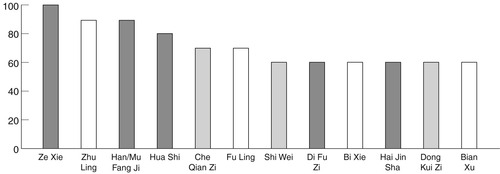 |
| Fig. 6.1. |
| Comparison of the herbs that regulate the Bladder and promote urination. Ze Xie ( Alismatis rhizoma), Zhu Ling ( Polyporus), Han/Mu Fang Ji ( Stephaniae tetrandrae radix/ Aristolochiae fangchi radix), Hua Shi ( Talcum), Che Qian Zi ( Plantaginis semen), Fu Ling ( Poria), Shi Wei ( Pyrrosiae folium), Di Fu Zi ( Kochiae fructus), Bi Xie ( Dioscoreae hypoglaucae rhizoma), Hai Jin Sha ( Lygodii spora), Dong Kui Zi ( Malvae semen), Bian Xu ( Polygoni avicularis herba). |
 |
| Fig. 6.2. |
| Comparison of the herbs that regulate the Heart and Small Intestine, promote urination and drain Damp-Heat. Mu Tong ( Mutong caulis)*, Zhi Zi ( Gardeniae fructus), Qu Mai ( Dianthi herba), Dan Zhu Ye ( Lophatheri herba), Yu Mi Xu ( Maydis stigma), Deng Xin Cao ( Junci medulla), Chi Xiao Dou ( Phaseoli semen). |
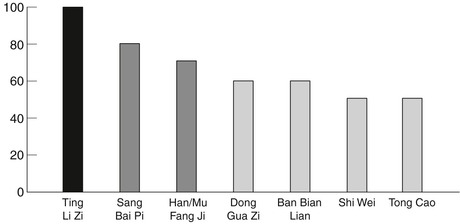 |
| Fig. 6.3. |
| Comparison of the herbs that regulate the Lung and promote urination. Ting Li Zi ( Lepidii/Descurainiae semen), Sang Bai Pi ( Mori cortex), Han/Mu Fang Ji ( Stephaniae tetrandrae radix/ Aristolochiae fangchi radix), Dong Gua Zi ( Benincasae semen), Ban Bian Lian ( Lobelia chinensis herba), Shi Wei ( Pyrrosiae folium), Tong Cao ( Tetrapanacis medulla). |
 |
| Fig. 6.4. |
| Comparison of the herbs that regulate the Spleen and Stomach, promote urination and drain Dampness. Fu Ling ( Poria), Yi Yi Ren ( Coicis semen), Tong Cao ( Tetrapanacis medulla), Bi Xie ( Dioscoreae hypoglaucae rhizoma), Da Fu Pi ( Arecae pericarpium). |
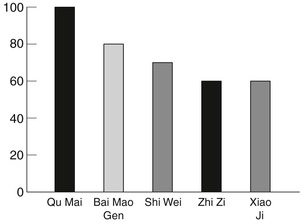 |
| Fig. 6.5. |
| Comparison of the herbs that promote urination and stop bleeding. Qu Mai ( Dianthi herba), Bai Mao Gen ( Imperatae rhizoma), Shi Wei ( Pyrrosiae folium), Zhi Zi ( Gardeniae fructus), Xiao Ji ( Cirsii herba). |
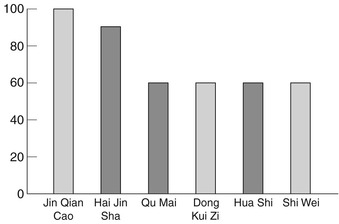 |
| Fig. 6.6. |
| Comparison of the herbs that promote urination, clear Damp-Heat, stop bleeding and treat Stone-Painful Urinary Dysfunction syndrome. Jin Qian Cao ( Lysimachiae herba), Hai Jin Sha ( Lygodii spora), Qu Mai ( Dianthi herba), Dong Kui Zi ( Malvae semen), Hua Shi ( Talcum), Shi Wei ( Pyrrosiae folium). |

